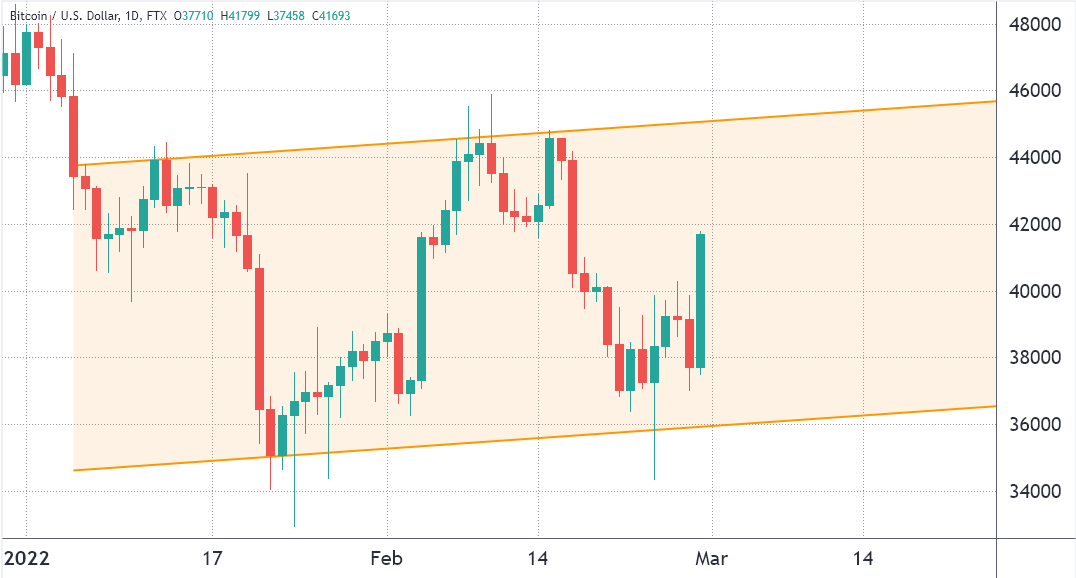Bitcoin (BTC) entered an upward channel in early January and despite the sideways trading near $40,000, order book analysts cited “significant buying pressure” and noted that the overall negative sentiment might be heading towards exhaustion.
 Bitcoin/USD price at FTX. Source: TradingView
Bitcoin/USD price at FTX. Source: TradingView
Independent analyst Johal Miles noted that BTC’s price formed a bullish hammer candlestick on its daily chart on Jan. 24 and Feb. 24, hinting that the longer-term downtrend is close to an end.
However, the rally above $41,000 on Feb. 28 was unable to create strong demand from Asia-based traders, as depicted by the lack of a China-based peer-to-peer Tether (USDT) premium versus the the official U.S. dollar currency.
Currently, there is positive news coming from the potential adoption of crypto by global e-commerce marketplace eBay. On Feb. 27, CEO Jamie Iannone revealed that the tech giant is looking to transition to new payment modes for part of its $85 billion in direct annual volume that is transacted on the platform.
Bitcoin bulls also have a strong case to leave room for upside price surprises if the European Commission plans to isolate Russia from the international SWIFT cross-border payment network system.
In addition to cutting off Russia from SWIFT, the European Commission will “paralyze the assets of Russia’s central bank.” Whether or not intended, this showcases Bitcoin’s decentralization benefits as an uncensorable means of exchange and a store of value.
The risk reversal strategy fits the current scenario
Albeit the popular belief that futures and options are widely used for gambling and excessive leverage, the instruments were actually designed for hedge (protection).
Options trading presents opportunities for investors to profit from increased volatility or obtain protection from sharp price drops and these complex investment strategies involving more than one instrument are known as options structures.
Traders can use the “risk reversal” options strategy to hedge losses from unexpected price swings. The investor benefits from being long on the call options, but pays for those by selling the put. Basically, this setup eliminates the risk of the stock trading sideways but does come with substantial risk if the asset trades down.
 Profit and loss estimate. Source: Deribit Position Builder
Profit and loss estimate. Source: Deribit Position Builder
The above trade focuses exclusively on Mar. 31 options, but investors will find similar patterns using different maturities. Bitcoin was trading at $41,767 when the pricing took place.
First, the trader needs to buy protection from a downside move by buying 2 BTC puts (sell) $34,000 options contracts. Then, the trader will sell 1.8 BTC put (sell) $38,000 options contracts to net the returns above this level. Finally, buying 3 call (buy) $52,000 options contracts for positive price exposure.
Investors are protected from a price drop to $38,000
That options structure results in neither a gain or a loss between $38,000 (down 9%) and $52,000 (up 24.5%). Thus, the investor is betting that Bitcoin’s price on Mar. 31 at 8:00 am UTC will be above that range while gaining exposure to unlimited profits and a maximum 0.214 BTC loss.
If Bitcoin price rallies toward $56,000 (up 34%), this investment would result in a 0.214 BTC gain. Even though there is no cost associated with this options structure, the exchange will require a margin deposit to cover potential losses.
The views and opinions expressed here are solely those of the author and do not necessarily reflect the views of Cointelegraph. Every investment and trading move involves risk. You should conduct your own research when making a decision.






